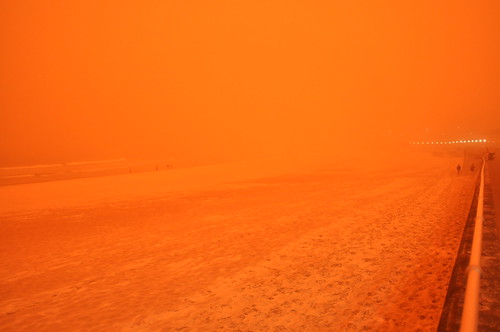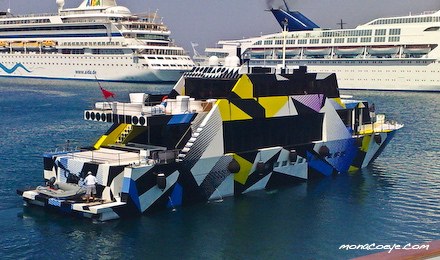
Last year Jeff Koons covered Dakis Joannou’s angular yacht Guilty [designed by Ivana Porfiri] with a pattern inspired by WWI naval camouflague. The technique, known in the US as Razzle Dazzle and in the UK as just Dazzle Painting, was created by the British artist Norman Wilkinson.
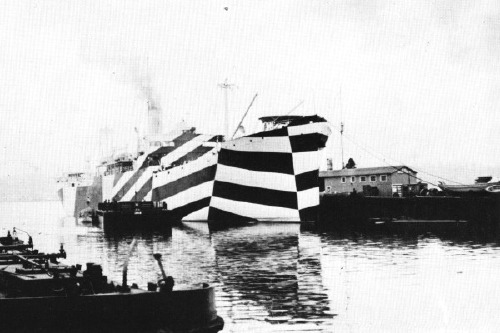
Dazzle deployed Cubism’s multiple perspective and fragmentation to thwart the aim of German U-boat attacks by obscuring the ships’ dimensions and traveling directions. The advent of sonar eliminated the need for visual targetting–and the utility of Dazzle Painting.
Ironically, Koons camo design made it exponentially easier for the yachtspotters at Monaco Eye to shoot Guilty in port last summer.
Dazzle Painting history and images [gotouring.com]
The US Navy apparently kept using Razzle Dazzle techniques through WWII. A large collection of 455 lithographs of camouflage designs was discovered in 2008 at RISD, the 1919 donation of an alumnus, Maurice Freedman, who was a camouflage painter during the war. They were exhibited for the first time last spring. [Dazzle Camouflage on Wikipedia]
Gerhard Street View
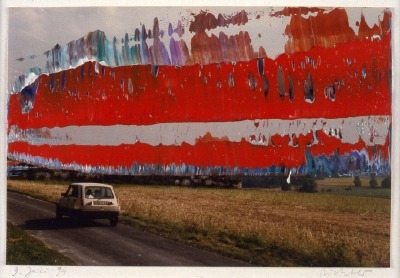
A Google Street View image of a French radar-jamming installation obscured by order of the Ministry of Defense or an overpainted photograph by Gerhard Richter? You decide.
Houses Of Orange

NL Architects thinks it might make a good Herzog & deMeuron project, but I think Google Maps’ security pixelization of the Dutch Royal House’s Noordeinde Palace in Den Haag would make an absolutely fantastic series of landscape paintings.
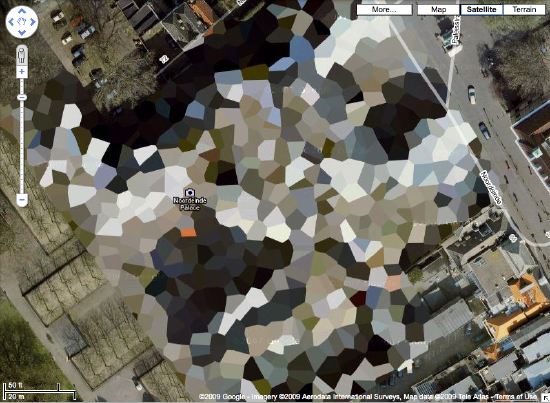
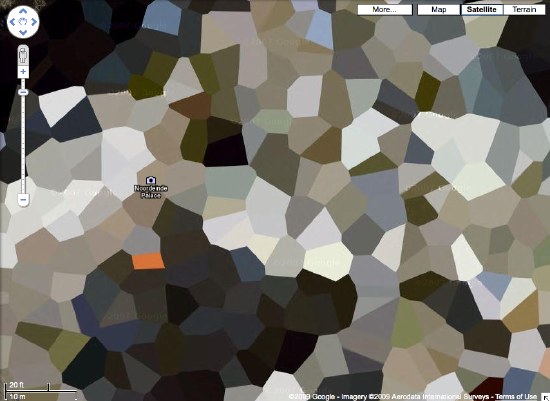
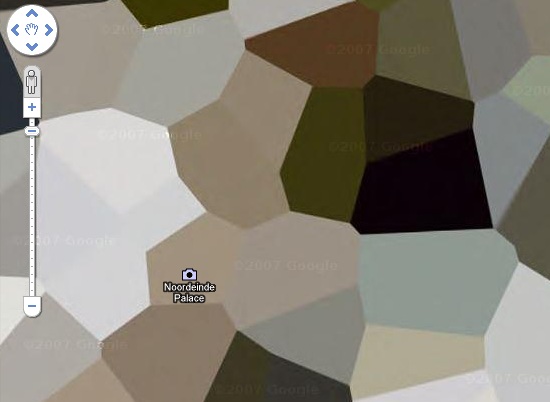
Where else in the world are such things? The DRH’s summer palace at Huis ten Bosch; an AZF chemical weapons factory in Toulouse…
There’s a surely incomplete list of obscured satellite images on Wikipedia, and a map. Which includes Mastercard’s corporate headquarters in Westchester, which actually looks like it was painted over. They call it “watercolored.” Perfect.
here’s the list of camo’d Dutch sites I’ve been working with.
Previously:
architecture for the aerial view, including WWII factory roof camouflage: the roof as nth facade
art for the aerial view: Calder on the roof
If You Don’t Make It Here, You’ll Make It Anywhere
Sheesh, build an Empire State Building out of Erector Sets at Rockefeller Center and the NY Times still thinks you’re dead:
The greatest enchantments at Inhotim are produced by works that not only draw on powerful subconscious currents but that also could only have come into being in this place, in Brazil. I am thinking, for instance, about Chris Burden’s ”Beam Drop,” a sculpture that — like a lot of work by this artist, who is so steeped in art-world legend it sometimes seems surprising that he exists and is still at work — was realized only once before, in 1984, in a version that has disappeared.
Never mind that Burden made another “Beam Drop” in Antwerp. Or that the original “Beam Drop” was made in New York, too.
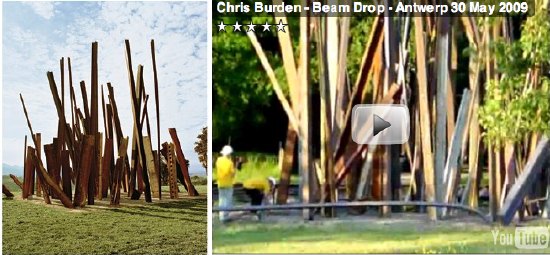
Meanwhile, this is as good a time as any to hate on the insanely intrusive ads that pop over Every. Single. #$)(%*ing. Page of T Magazine? It’s like walking into Saks and getting spritzed by a hundred perfume salespeople desperate not to lose their jobs.
Tripod-For-Handheld
Gruber calls this Windows 7 Launch Party video “cringe-inducing,” and it certainly is. Though I’m pretty sure the technical term for erratic, pointless, exaggerated simulation of handheld camera movement using a fixed camera and a pan handle is seizure-inducing.
That said, the dialogue is so bafflingly abstract, it’s almost sublime. I’m sure it’s because they didn’t have party “activities” website finished before the shoot, but this video could have a future as an insider’s critique of the corporate existential void. “Windows for Godot.”
The Weather Project, Not By Olafur Eliasson
au.bondi.2009.058
Lose 10 Lbs With My Exclusive Red Vines Diet!
1. Pop open a Diet Coke.
2. Eat all the Red Vines you want.
3. uh, actually that’s as far as I’ve gotten.
Black Mountain College Building Mystery Solved
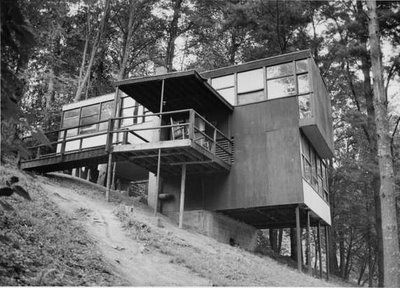
Last month, when I tried to identify this kind of awesomely simple house at Black Mountain College [from a photo in UConn’s Charles Olson Collection], the best I could do was a guess, that it was A. Lawrence Kocher’s plywood-based Service Building, built in the 1940’s to house the BMC’s African American kitchen staff.
Well, thanks to the Internet, these things have cleared themselves up. I just got an email from Leigh, who lives and works at Lake Eden Events, an event and destination operation on the BMC site. She pointed me to the BMC Project website, which has the answer.
This is, in fact, the Science Building, designed and built between 1949 and 1953 by faculty architect Paul Williams in collaboration with students Dan Rice and Stan VanDerBeek. [Yes, that Stan VanDerBeek.] From BMCProject:
A site on the lower rim of the knoll just south of the Studies Building was selected, and Williams, Rice, and VanDerBeek started construction in December. By August 1950 lights were on in the building. By January 1951, construction was not complete. An engineer was called in to help find the cause of structural problems which were causing the window panes to shatter the lower front frame to separate where the floor overhung the columns. He concluded that the building was structurally sound, and that bending 2 x 4s had caused the problem.
The building was finished in the winter of 1953 not long before the resignation of Natasha Goldowski, science teacher. She refused to use the building, concerned that it would collapse on the hill. When the lower campus was closed, the looms were moved from the art studio in the Studies Building to the science building.
The building is, in fact, still standing. Camp Rockmont uses it for staff housing. Check out blackmountaincollegeproject.org for some tiny photos.
Now about that Kocher Service Building. Leigh also notes that the only photos she’s ever seen of it are from the NC State Archives, [also on BMC Project]. It looked pretty basic and boring, with a shallow, pitched roof. Also, it burned down less than two years after it was completed.
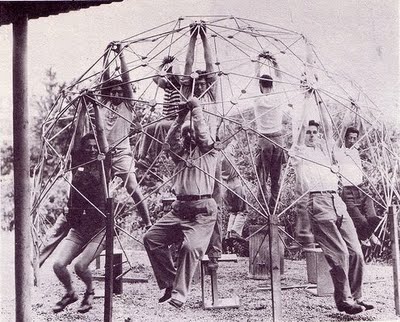
As for this VanDerBeek at Black Mountain thing. Buckminster Fuller taught at BMC for two summers. In 1948, he had his students try to build the first of his geodesic domes out of venetian blind strips. By 1949, Fuller brought a much more successful prototype of a collapsible dome made from aircraft aluminum tubing threaded with cable. I suspect VanDerBeek–who went on to build his own countryside dome for showing immersive, multi-projector films, the Movie-Drome, is one of those khaki monkeys hanging off of it in the photo above.
That’s the thing with domes; even if you head out in the opposite direction, eventually, you find your way right back.
10/2014 update: URLs for the Black Mountain College Project have been updated. The BMC Project materials are being prepared for inclusion in the Western Regional Archives collection, which opened last year near Asheville, NC. The khaki monkeys picture above is credited to Masato Nakagawa.
Have You Seen Me? The Find The Warhols Project
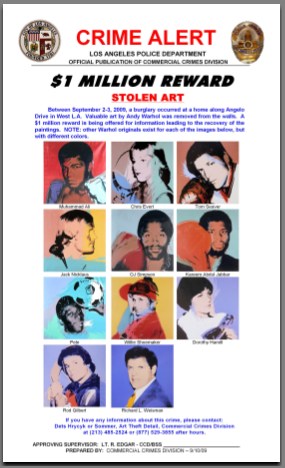
Earlier this month eleven portrait paintings by Andy Warhol were reported stolen from the home of Los Angeles collector Richard Weisman. The paintings, known the Athletes Series, depict some of the greatest athletes in the world in 1977, plus Weisman. There is a $1 million reward for information leading to their return.
When one man’s Warhols are stolen, all our Warhols are stolen, because no matter how many Warhols you technically own, Warhol belongs to all of us. It’s imperative that we band together to help these Warhols return to their rightful home [so they can be sold]. Which is why greg.org is announcing The Find The Warhols Project.
MISSION
The Find The Warhols Project seeks to facilitate the safe return of the Weisman Warhols by assisting in the dissemination of crucial identifying information where it is needed most: on the front lines of the art world.
FTW will educate and empower an ever-vigilant grass roots army of Warhol Watchers who will be able to quickly spot the stolen Warhols from among the thousands of Warhols streaming through the art world every day.
THE PROJECT
Many, many Warhols look the same, especially the 40×40-in. square silkscreened portraits of seemingly random people who were rich and/or famous in the 70’s and 80s. This can make it hard to tell if a Warhol is hot or not.
For example, just look at these three seemingly identical Muhammad Ali portraits. Can you tell which one is stolen, which one sold for triple its high estimate, and which one was still available last summer in Beijing?

Fortunately, on September 10th, 2009, The Los Angeles Police Department’s Art Theft Detail released a one-page, notepad-sized Crime Alert [top] with reproductions of the exact eleven stolen paintings and a critical detail: “NOTE: other Warhol originals exist for each of the images below, but with different colors.”
This is an invaluable crimebusting tool that needs to be distributed as widely as possible and studied regularly whenever you buy, sell, see, hang, ship, frame, conserve, appraise, authenticate, license for marketing, or critique a Warhol.
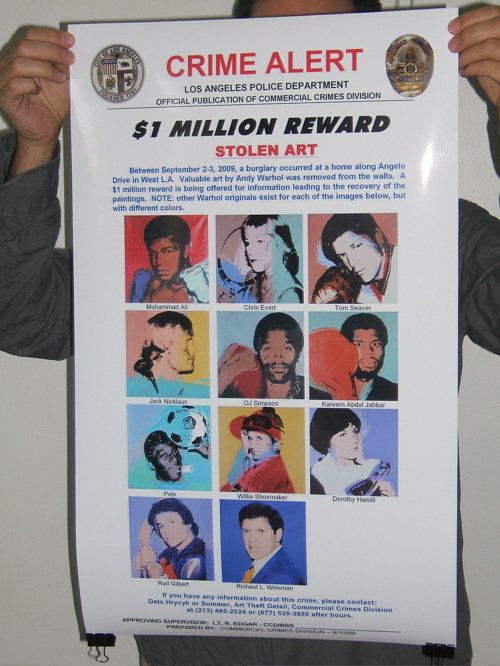
To that end, FTW will take this crucial-but-small Crime Alert and make larger versions which will enable quick and certain detection at a glance. These giant, poster-sized versions will be offset print in full color on 100-lb glossy paper, and will be suitable for hanging by Warhol Watchers at key art world locations with high Warhol traffic, including:
- Art gallery backrooms
- Private dealers’ showrooms
- Hedge fund conference rooms
- Park Avenue cosmetic surgeons’ waiting rooms
- West Village real estate developers’ conference rooms
- West Village townhouse stagers’ conference rooms
- Collectors’ offices
- Private curators’ offices
- Museum curators’ offices or cubicles
- Independent curators’ hallways, since it is unlikely they have offices
- Curatorial studies graduate program student lounges
- Auction house cube farms
- Art magazine offices
- Art magazine freelance writers’ walls above the beds where they write because they can poach the neighbor’s wi-fi from there
- Art organization benefit auction organizers’ conference rooms
- Art fair booth backrooms
- Art fair concierge desks
- Art fair VIP lounges
- Art fair sponsor VIP lounges
- Fractional ownership jet terminals
- Museum development directors’ assistants’ offices
- Museum registrars’ offices
- Museum freight elevators
- Crate fabricators’ workshop offices
- Framers
- &c., &c.
HOW YOU CAN HELP
- Get some FTW Crime Alert posters.
- Put them up in your own corners of the art world.
- Study the details of the Stolen Warhols frequently to keep them fresh in your mind.
- Whenever you buy, sell, or otherwise encounter a Warhol, check it against the Crime Alert poster to see if yours is one of the Stolen Warhols.
- Encourage others to do the same by writing about the FTW Project on your blogs, by giving posters to other collectors and dealers and art world friends, by holding FTW Happenings in your lofts to build awareness and learn the paintings, &c.
FTW Crime Alert posters are available for pre-order through Kickstarter starting at $10 for two, to cover the cost of printing [$883] and shipping [$3.62/order]. Orders will only be processed and the posters will only be printed and shipped as soon as 141 pre-orders are received. If the Stolen Warhols are found before FTW reaches 141 pre-orders, the Project will cease, no posters will be printed, and no orders will be charged or fulfilled. The FTW Project Kickstarter page has more information, including details of how Kickstarter pledges work, as well as options for ordering multiple posters, for international shipping, and for collectors who own more than 11 Warhols.
BACKGROUND
The Warhols, known as the Athlete Series were commissioned by Richard Weisman in 1977 for the purpose of bringing the world’s two greatest leisure pastimes–sport and art–together. They are all portraits of famous athletes posing with the primary implement of their chosen sport next to their heads. Plus a headshot of Weisman himself, whose mother co-founded the Museum of Contemporary Art in Los Angeles, and whose uncle Norton Simon founded the Norton Simon Museum.
Warhol produced eight complete sets of the paintings for Weisman, plus an unidentified number of additional individual paintings. Two sets were broken up and given to each athlete and his or her sports governing body. Weisman donated two sets to university collections. Weisman’s three kids each got a set. And he kept one for himself. Total price tag for the project: a reported $800,000.
All the works are 40×40 inches, silkscreen and polymer paint on canvas. Warhol also created other, differently sized versions of some images. Except for the Muhammad Ali paintings, all the canvases were signed by the athletes at the time of their completion. For Ali, Weisman had Ali sign five paintings [presumably the non-donated ones: his own, his kids’ and one extra, see below] during a visit to Los Angeles in 1991. Each silkscreened canvas was painted in a unique color combination.
Weisman began marketing his set several years ago. He loaned it to the Warhol Museum in 2005. In 2007, it was offered for sale in London by the dealer Martin Summers for $28 million, along with several individual paintings. It was still for sale in 2008, when he showed it in Beijing during the Olympics.
The 2007 show also included a loosie Ali portrait with a purple ground, above right.] A couple of months later, Ali’s own red & green painting [above middle], which had been given to his ex-wife, sold at Christie’s for $9.2 million.
So you can see how vitally important these Warhols are, especially to Weisman. They’re practically his children. Children he can sell for an eight-figure price. And children whose safe return could bring a million dollars to the one who makes it happen. Won’t you help?
And That’s Why They Call It Total

So I’m just walking back in from the hardware store, when I realize I missed a call from a Utah number. I call it back, the ringer goes all funny, and it turns out to be the cell phone of my mom’s new husband Spence [congratulations, you guys!], and they’re on the side of the road in Giverny, on their way to dinner when the bad tank of gas they bought finally does their Hertz car in, and it won’t start.
Hertz France doesn’t do jack, and the Hertz Paris office closed early, apparently, and while the Hertz US folks are helpful and promise to file a poor service report on their French counterparts, that still doesn’t help them get back to their inn. American Express and their concierge service, for which they pay an inordinate annual fee, primarily on the off chance that, if they get stuck on the road somewhere, AmEx has their back, got disconnected just as they got all their info into the system, and that’s right when I called back.
So I call Hertz Paris, and it’s supposed to be open for another 45 minutes, but there’s no answer. Then I go to Mappy.fr, because really, their maps kill for Europe, and sure enough, there’s their hotel, and I can map all the service stations nearby and even see how much gas is. But there are no phone numbers, so I Google up the closest one with a service bay–because in the country, they sometimes just have tiny little gas-only stations–and call.
And some guy answers, and I explain I’m calling from the US, and my mother’s on the side of the road, trying to get back to the inn in whatever village, and he’s all, “Is that the one run by Nicole?” And I’m like, “Je ne sais pas,” but it’s the one just off Rue du Port, and he’s all, “Yeah, Nicole.”
And I tell him what they’re driving [grey Opel], and about where they are, and he says he’ll call Nicole and let her know, then head out to pick them up. And so I call them back, and I’m like, “Do you know someone named Nicole?” And they’re all, “Oh, she’s the woman who runs our inn.” And I’m all, “A guy from the Total station will be there in a few minutes.”
And then I primed the inside of the closet and called them back, and they were at the inn, eating dinner, and the guy had told them, sure enough, “mauvais essence,” and he’s bringing their car back in the morning, pas de probleme.
And now I’m thinking it was only 1992 when we were freaking out over them monitoring the terrorist kill from Langley in real time in Patriot Games, and now here I am, literally watching paint dry while I give directions to the tow truck driver half way around the world. What a crazy world.
The Thom Assclown Affair
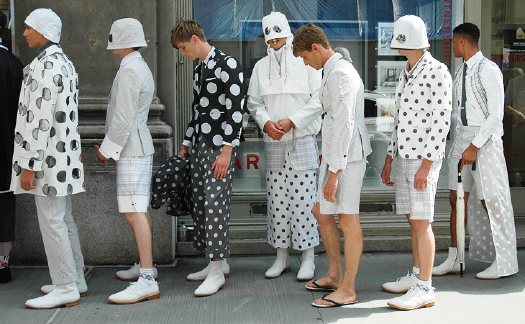
In the past, people criticized fashion shows because the looks from the runway never made it to the street. Well, Thom Browne sure showed them.
Tommy Ton’s photoset of Browne models waiting to enter his show is an instant classic.
Backstage: Thom Browne Lineup [jakandjil.com via kottke, the awl]
Ai Weiwei Undergoes Emergency Surgery In Munich
For a month after being beaten and detained by Chinese police, artist Ai Weiwei had complained of constant headaches. While in Munich to install a show, he went to a doctor, who sent him into emergency surgery to alleviate a cerebral hemorrhage. The news was reported, of all places, by the editor’s blog at Frieze magazine, which published accounts from his assistant and one of the artist’s fellow activists involved in publicizing the names of 5,000 children killed in school collapses in the Sichuan earthquake.
Ai has been publishing photos and updates [in Chinese] on Twitter.
Ai Weiwei in hospital after police brutality [frieze.com]
Ai Weiwei erhebt schwere Vorwürfe gegen Peking [sueddeutsche zeitung]
The Sentence As Earthwork
Not that it doesn’t sound fascinating, but a diagram of this sentence would be as big as the Lightning Field itself:
In this lecture Chris Taylor will present Land Arts of the American West as a work that makes other works through a field program that investigates the intersection of geomorphology and human construction beginning with the land and extending through the complex social and ecological processes that produce contemporary landscapes.
From the description of “Measures of Time, Travel, and Space: exploring Land Arts of the American West,” presented last April at Yale. [land arts via tyler]
Much Is Published, But Little Printed
From Henry David Thoreau’s Walden, quoted by Mark Noonan in the Columbia Journal of American Studies
But while we are confined to books, though the most select and classic, and read only particular written languages, which are themselves but dialects and provincial, we are in danger of forgetting the language which all things and events speak without metaphor, which alone is copious and standard. Much is published, but little printed. The rays which stream through the shutter will be no longer remembered when the shutter is wholly removed. No method nor discipline can supersede the necessity of being forever on the alert. What is a course of history, or philosophy, or poetry, no matter how well selected, or the best society, or the most admirable routine of life, compared with the discipline of looking always at what is to be seen? Will you be a reader, a student merely, or a seer?

For a long time we had construction on our street. The crew would store their portable signs in such a way that, on many mornings, they would reflect a rainbow in our window and across our living room ceiling. The kid took on the job of spotting them, which led to her taking pictures of them. This is one of the earliest examples. I suspect the memory of the rays will far outlast our shutters which, frankly, are nothing special and which I can’t wait to remove.
On The Public-Sculpture Gravy Train
It’s got shiny spheres, and science re-creations, and DC artists and quotes from curator and museum director friends. But it’s been a few weeks now, and the only thing I can say about Blake Gopnik’s mind-numbing/blowing article on Jim Sanborn is that this passage on public art is pretty damn funny:
The fame of the CIA commission “funded me for all the years since,” Sanborn says. It put him on the public-sculpture gravy train. He stopped living in his scruffy studio building in Northeast Washington (it’s where he met his wife, Jae Ko, a well-known local sculptor), bought a house in Georgetown, designed a home in the Shenandoahs and continued to fund his more “serious” art, such as “Atomic Time.”
But lately, the commissions have dried up. Today’s selection panels, he complains, go for “decorative embellishments.”
Damn those panels. If only noted art historian/author Dan Brown would write a book about Washington, he could include another mention of Sanborn’s work.
??!!??: Sparking Interest Within the Sphere of Art | ‘Physics’ May Be Most Substantive D.C. Piece in Half-Century [washingtonpost via man]

